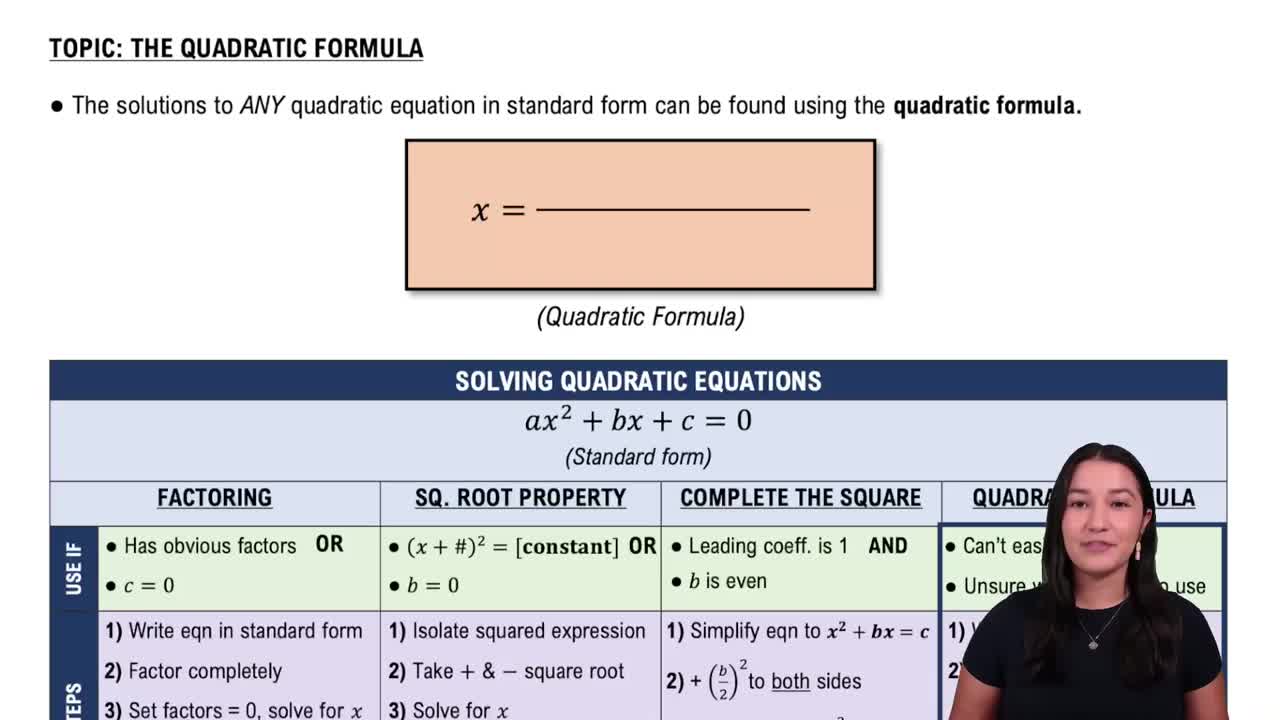Table of contents
- 0. Review of Algebra4h 16m
- 1. Equations & Inequalities3h 18m
- 2. Graphs of Equations43m
- 3. Functions2h 17m
- 4. Polynomial Functions1h 44m
- 5. Rational Functions1h 23m
- 6. Exponential & Logarithmic Functions2h 28m
- 7. Systems of Equations & Matrices4h 6m
- 8. Conic Sections2h 23m
- 9. Sequences, Series, & Induction1h 19m
- 10. Combinatorics & Probability1h 45m
1. Equations & Inequalities
Linear Inequalities
Problem 50c
Textbook Question
Solve each quadratic inequality. Give the solution set in interval notation. See Exam-ples 5 and 6. x^2>16
 Verified step by step guidance
Verified step by step guidance1
Rewrite the inequality as a quadratic equation: \(x^2 = 16\).
Solve the quadratic equation \(x^2 = 16\) by taking the square root of both sides, which gives \(x = 4\) and \(x = -4\).
These solutions divide the number line into three intervals: \((-\infty, -4)\), \((-4, 4)\), and \((4, \infty)\).
Test a point from each interval in the original inequality \(x^2 > 16\) to determine which intervals satisfy the inequality.
Based on the test results, write the solution set in interval notation, including only the intervals where the inequality holds true.
Recommended similar problem, with video answer:
 Verified Solution
Verified SolutionThis video solution was recommended by our tutors as helpful for the problem above
Video duration:
2mPlay a video:
Was this helpful?
Key Concepts
Here are the essential concepts you must grasp in order to answer the question correctly.
Quadratic Inequalities
Quadratic inequalities are expressions that involve a quadratic polynomial set in relation to a value, typically using inequality symbols such as '>', '<', '≥', or '≤'. To solve these inequalities, one must determine the values of the variable that satisfy the inequality, often by finding the roots of the corresponding quadratic equation and testing intervals.
Recommended video:
Guided course

Nonlinear Inequalities
Interval Notation
Interval notation is a mathematical notation used to represent a range of values. It uses parentheses and brackets to indicate whether endpoints are included (closed intervals) or excluded (open intervals). For example, the interval (2, 5] includes all numbers greater than 2 and up to and including 5.
Recommended video:

Interval Notation
Graphing Quadratics
Graphing quadratics involves plotting the quadratic function on a coordinate plane to visualize its shape, which is a parabola. The vertex, axis of symmetry, and intercepts are key features that help in understanding the behavior of the quadratic function, particularly in determining where it is above or below a certain value, which is essential for solving inequalities.
Recommended video:

Solving Quadratic Equations Using The Quadratic Formula
Related Videos
Related Practice













